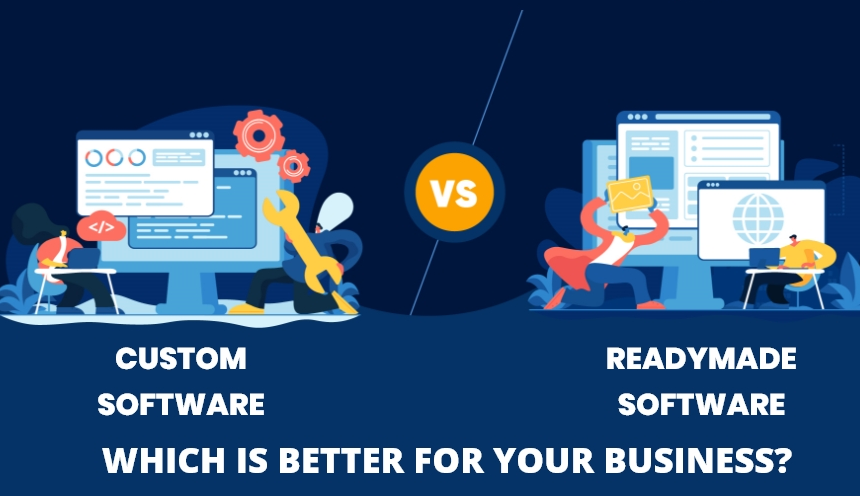Understanding the Distinction:1.Custom Software vs. 2.Ready Software
(Ready Software / Custom software)In the dynamic realm of technology, the choice between custom-built software and ready-made Ready Software holds substantial significance for businesses and individuals alike. This decision significantly impacts the efficiency, functionality, and scalability of software applications. Let’s explore in depth the nuances, benefits, drawbacks, and suitability of these distinct categories across various domains.
Table of Contents
ToggleCustom Software: Tailored Solutions for Unique Needs
Definition and Characteristics Custom software, also referred to as bespoke or tailor-made software, encompasses applications specifically designed and developed to meet the unique requirements of a particular user, organization, or industry. Unlike ready software, custom software is crafted from scratch, meticulously tailored to address specific business processes, workflows, and challenges.
Key Advantages
-
- Tailored Precision: Custom software is engineered to align perfectly with the unique needs and workflows of an organization, leading to enhanced efficiency and productivity.
- Scalability: It allows for easy scalability, as it can be adjusted and expanded as the business evolves or requirements change.
- Flexibility and Integration: Custom software seamlessly integrates with existing systems and offers greater flexibility in terms of features and functionalities.
- Competitive Edge: Provides a competitive advantage by offering unique functionalities or processes that are not readily available in off-the-shelf solutions.
- Long-Term Cost Efficiency: While initial development costs might be higher, in the long run, maintenance costs might be lower as it’s tailored to fit precise needs, eliminating unnecessary features or complexities.
- Enhanced Security Measures: Custom software can prioritize specific security features tailored to the business’s needs, potentially providing higher levels of data protection and reducing vulnerabilities.
- Ownership and Control: Organizations have full ownership and control over custom software, enabling them to make changes or enhancements as needed without being dependent on third-party vendors.
- Focused User Experience: Tailored software can provide a more intuitive and user-friendly interface, as it’s designed with the specific end-users in mind, potentially boosting user adoption and productivity.
- Tailored Precision: Custom software is engineered to align perfectly with the unique needs and workflows of an organization, leading to enhanced efficiency and productivity.
Drawbacks and Challenges
-
- Higher Initial Investment: Custom software development generally involves higher upfront costs due to the need for comprehensive design, development, and testing phases.
- Development Time: The development cycle for custom software is longer compared to ready software, potentially delaying time-to-market.
- Dependency on Development Team: There’s a reliance on the expertise and availability of the development team, impacting updates, maintenance, and support.
- Scope Management: Defining the scope of custom software can be challenging, as evolving requirements or changes in business processes might lead to scope creep, impacting timelines and budgets.
- Technology Evolution: Keeping up with rapidly evolving technologies and ensuring the software remains up-to-date in terms of features, security, and compatibility can be a continuous challenge.
- Higher Initial Investment: Custom software development generally involves higher upfront costs due to the need for comprehensive design, development, and testing phases.
Ready Software: Off-the-Shelf Solutions for Immediate Use
Definition and Characteristics Ready software, commonly known as off-the-shelf or pre-packaged software, refers to mass-produced solutions readily available for purchase or licensing by a broad audience. These solutions cater to general needs and are not specifically customized for any particular user or organization.
Key Advantages
-
- Quick Deployment: Ready software can be deployed swiftly as it’s readily available, allowing for immediate use without extensive development time.
- Cost-Effectiveness Initially: Often, the initial cost of purchasing off-the-shelf software is lower compared to custom solutions, making it more accessible for smaller businesses or individuals.
- Maintenance and Support: Generally, Ready software comes with support and maintenance provided by the vendor, reducing the burden on the user for updates and fixes.
- Proven Track Record: Established Ready software often has a track record of successful implementations and user feedback, providing a level of reliability.
- Community Support and Resources: Established Ready Software often has a thriving user community, providing access to forums, tutorials, and additional resources for troubleshooting and support.
- Ease of Adoption: With familiar interfaces and functionalities, ready software generally requires minimal training for users, allowing for quicker adoption across the organization. 7. Industry Best Practices: Some Ready Software solutions embed industry-specific best practices, drawing from experiences across various businesses within the same domain.
- Quick Deployment: Ready software can be deployed swiftly as it’s readily available, allowing for immediate use without extensive development time.
Drawbacks and Challenges
-
- Limited Customization: Ready software might not fully align with specific business processes or unique needs, potentially requiring workarounds or compromises.
- Scalability Challenges: It might not easily adapt to rapid growth or changing business requirements, leading to limitations in scalability.
- Vendor Dependency: Users are reliant on the vendor’s update schedules, which might not always align with their specific needs or timelines.
- Risk of Redundancy: As technology evolves, off-the-shelf solutions can become outdated, requiring replacement or significant upgrades.
- Vendor Lock-in: Choosing a specific Ready Software might result in vendor lock-in, making it challenging to switch to alternative solutions without significant migration efforts.
- Customization Constraints: While some customization might be possible, significant alterations to the core functionalities of ready software might be restricted, limiting its adaptability to unique business processes.
- License Limitations: Licensing models might impose restrictions on the number of users, features, or instances, potentially adding costs as the business grows or requires additional functionalities.
- Limited Customization: Ready software might not fully align with specific business processes or unique needs, potentially requiring workarounds or compromises.
Conclusion:
Choosing the Right Fit :The decision between ready software and custom software is strategic and necessitates careful consideration of various factors, including budget, timeline, scalability needs, and specific business requirements. While ready software provides convenience and immediate usability, custom software offers unparalleled tailored solutions that precisely cater to an organization’s needs. Businesses must weigh these factors to determine which option best aligns with their short-term goals and long-term vision.

